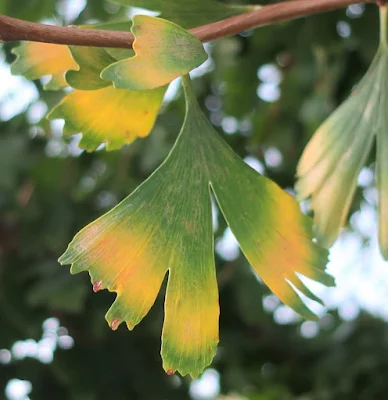Japanese follows English. 英語の後に日本語が続きます。
Bright yellow ginkgo leaves are everywhere across Japan. People enjoy the yellow leaves and other leaves turning orange, red and purple. But have you ever thought about how leaves change color?
Bright yellow ginkgo leaves are everywhere across Japan. People enjoy the yellow leaves and other leaves turning orange, red and purple. But have you ever thought about how leaves change color?
Information about "why" leaves change color in autumn is everywhere on the internet. According to "The Process of Leaf Color Change," in autumn triggered by shorter days and lower temperatures the leaves stop their food making process. The chlorophyll breaks down, the green colour disappears and the yellow and orange colours become visible. At the same time other chemical changes may occur which form additional colours through the development of red pigments. Some mixtures give rise to reddish and purplish autumn colours such as dogwoods and sumachs, while others give maple its brilliant orange. The autumn foliage of some trees show only yellow colours, whilst others like oaks show only brown. All these colours are the varying amounts of the chlorophyll residue and other pigments in the leaf.
I knew this because I watched a TV show telling mostly the same thing, but how? Does the color change happen in all parts of the leaves at the same time or from one part to another like these ginkgo leaves changing yellow from the edge to the middle? That's what I'm going to enjoy seeing for the next few days😊!
 |
| Ginkgo 銀杏 |
 |
| The edges of gingko leaves turn bright yellow 先の方から黄色に? |
(If you wish to post your comment but don't have a Google account, select "anonymous" from the drop down menu titled "comment as"!)
黄金色の銀杏の葉がいろんなところで楽しめる季節になりました。でも皆さん、紅葉の仕組みってご存じですか。
毎日新聞によると「気温が下がり、日照時間が短くなると、葉への栄養供給が止まる。その結果、クロロフィルが分解され、別の色素と作用して色付く」のだそうです。テレビでも同様の説明を聞いたことがあります。でもどのように紅葉するかはご存じですか。全体的に徐々に紅葉するのか、それとも葉の一部から他の部分へと順繰りに紅葉するのか?
で見つけたのがこの銀杏。葉の先の方から中ほどに向かって色づいているような気がしませんか?これから数日見守ります😊!
(Google アカウントを持ってない方は、コメント記入後に「Google アカウント」をクリックし、「匿名」か「名前/URL」を選択してからご記入ください!)


0 件のコメント:
コメントを投稿